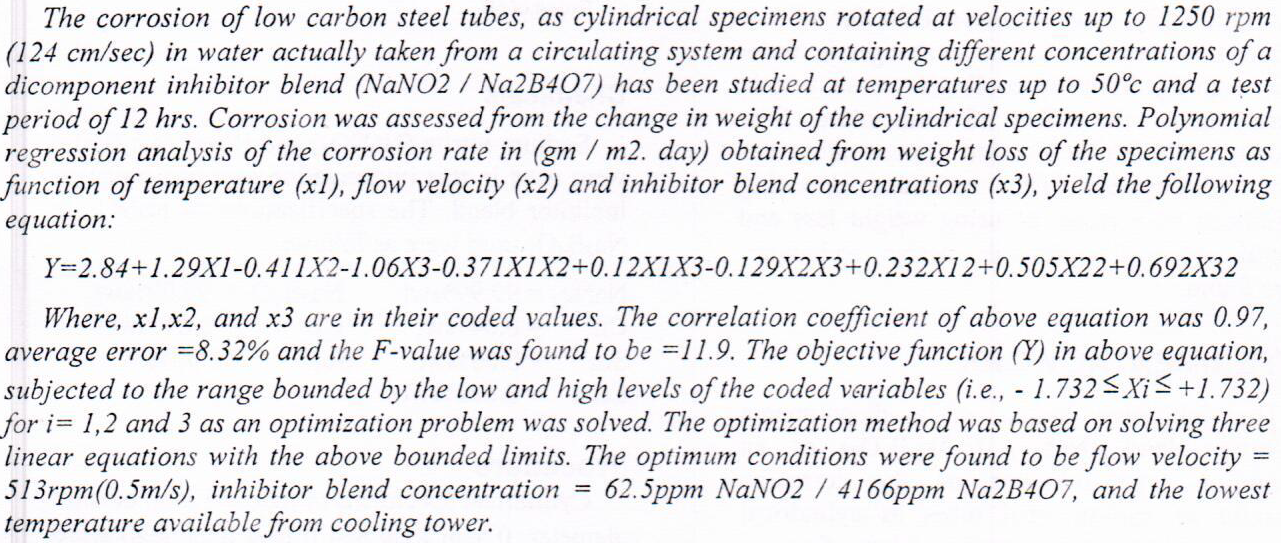
This study shows that it is possible to fabricate and characterize green bimetallic nanoparticles using eco-friendly reduction and a capping agent, which is then used for removing the orange G dye (OG) from an aqueous solution. Characterization techniques such as scanning electron microscopy (SEM), Energy Dispersive Spectroscopy (EDAX), X-Ray diffraction (XRD), and Brunauer-Emmett-Teller (BET) were applied on the resultant bimetallic nanoparticles to ensure the size, and surface area of particles nanoparticles. The results found that the removal efficiency of OG depends on the G‑Fe/Cu‑NPs concentration (0.5-2.0 g.L-1), initial pH (2‑9), OG concentration (10-50 mg.L-1), and temperature (30-50 °C). The batch experiments showed
... Show More (11)
(11)
 (9)
(9)
Hepatitis C virus (HCV) is a liver disease that affects14 million people. Feasible research was conducted for identifying the genotypes and allele frequency of some single nucleotide polymorphisms (SNPs) of the IL-28β genes and their predictive role in disease incidence in Iraqi patients. The SNPs (rs28416813, rs4803219, rs11881222, and rs8103142) of IL-28β have been associated with susceptibility to several diseases. Ninety eight (98) HCV patients were included in this research; with average age ± SE (42.28 ± 3.44) years. Also, 80 healthy people (with average age ± SE (29.40 ± 2.84) years) were included as a control group. The SNPs were detected by allele-specific PCR (polymerase chain reaction) using specific primers. The re
... Show More (2)
(2)
 (5)
(5)
 (3)
(3)
 (1)
(1)
 (1)
(1)
Novel derivatives of 1-(´1, ´3, ´4, ´6-tetra benzoyl-β-D-fructofuranosyl)-1H- benzotriazole and 1-(´1, ´3, ´4, ´6-tetra benzoyl-β-D-fructofuranosyl)-1H- benzotriazole carrying Schiff bases moiety were synthesised and fully characterised. The protection of D- fructose using benzoyl chloride was synthesized, followed by nucleophilic addition/elimination between benzotria- zole and chloroacetyl chloride to give 1-(1- chloroacetyl)- 1H-benzotriazole. The next step was condensation reaction of protected fructose and 1-(1-chloroacetyl)-1H- benzotriazole producing a new nucleoside analogue. The novel nucleoside analogues underwent a second conden- sation reaction with different aromatic and aliphatic amines to provide new Schiff b
... Show MoreThe effects of nutrients and physical conditions on phytase production were investigated with a recently isolated strain of Aspergillus tubingensis SKA under solid state fermentation on wheat bran. The nutrient factors investigated included carbon source, nitrogen source, phosphate source and concentration, metal ions (salts) and the physical parameters investigated included inoculum size, pH, temperature and fermentation duration. Our investigations revealed that optimal productivity of phytase was achieved using wheat bran supplemented with: 1.5% glucose. 0.5% (NH4)2SO4, 0.1% sodium phytate. Additionally, optimal physical conditions were 1 × 105 spore/g substrate, initial pH of 5.0, temperature of fermentation 30˚C and fermentation dura
... Show More (7)
(7)
Aromatic Schiff-bases are known to have antibacterial activity, but most of these compounds are sparingly soluble in water. The present work describes the synthesis of new Schiff-bases derived from branched aminosugars. Treatment of 3-Amino-3-Cyano-3-Deoxy-1,2:5,6-Di-O-Isopropylene-α-D-Allofuranose (1) with the aldehydes (2) under reflux in methanol afforded the Schiff-bases (3) in good yields. The new Schiff-bases were in accord with their NMR, IR spectral data and elemental analysis.
In the current work, the mixing ratios ( 𝛿 ) of gamma transitions were calculated from energy levels in the isotopes neodymium 60𝑁𝑎 142−150 populated in the 60Nd 142− 150 (n, n ˊγ) 60Nd 142− 150 using the 𝑎2 ratio method. We used the experimental coefficient (𝑎2 ) for two γ-transitions from the initial state itself, the statistical tensor 𝜌2(𝐽𝑖), associated with factor 𝑎2 , would be the same for the two transitions. The results obtained are in good agreement or within the experimental error with -those previously published. And existing contradictions resulting from inaccuracies in the empirical results of previous work. The current results confirm that the , 𝑎2 − method is used to calculate th
... Show MoreMethicillin resistant Staphylococcus aureus (MRSA) is one of the principal nosocomial causative agents. This bacterium has the capability to resist wide range of antibiotics and it is responsible for many diseases like skin, nose and wounds infection. In this study, randomly amplified polymorphic DNA (RAPD)-PCR was applied with ten random primers to examine the molecular diversity among methicillin resistant Staphylococcus aureus (MRSA) isolates in the hospitals and to investigate the genetic distance between them. 90 Isolates were collected from clinical specimens from Iraqi hospitals for a total of 90 isolates. Only 10 strains (11.11%) were found to be MRSA. From these 10 primers, only 9 gave clear amplification products. 91 fragment l
... Show More (3)
(3)
